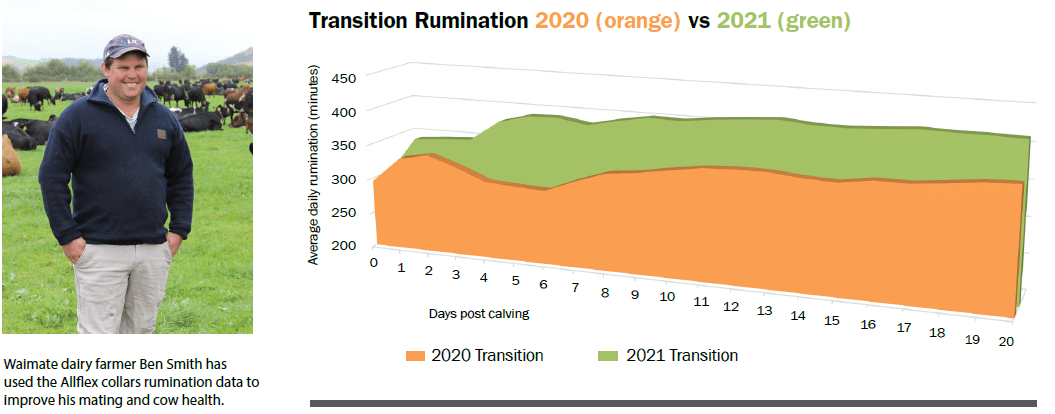Collars are gathering information on cows’ rumination to indicate ovulation for AI. Story and photos by Karen Trebilcock.
When Waimate dairy farmer Ben Smith bought Allflex collars for his cows to show heats for mating five years ago, he was scratching his head about the rumination data the collars were also collecting.
The collars detect heats using peak cow activity together with rumination times (picked up by the motion of the cow’s jaw moving side to side) which dip about 26 hours before ovulation.
The two data sets combined show when it is time to draft the cow for artificial insemination.
But with the collars worn year-round, there was a huge amount of data about rumination that Ben had no idea what to do with.
“Then I was dealing with the technical staff in Australia and they were asking me what was wrong with my cows because the rumination times were down at 300 minutes.
“I looked at the cows and they looked fine to me, like they always do at that time of year after calving but here was someone who couldn’t even see them saying there was something seriously wrong.”
His vet Ryan Luckman, of the Veterinary Centre, began collecting data from his clients with Allflex collars and started getting his head around the figures.
He now has more than 50 dairy farmers in the area with the collars and can look at the information as it’s generated.
“One of the cool things about the Allflex system is writing reports from the data is very easy – it’s all open access and I can look back two to three years and see how things happened on farm,” he told SIDE delegates at a workshop on reproduction in Oamaru in early June.
“I can benchmark all the data and with so much data coming in I can now advise farmers who don’t have the collars.”
And when he saw Ben’s rumination figures following calving he became concerned, just as the Allflex technician in Australia had been.
Cows don’t eat at calving but Ben’s cows still weren’t reaching at least 400 minutes/day rumination times required for good health until weeks later.
“They were in a huge energy loss and when I went forward and looked at his reproduction figures following calving they were also not good with cows not cycling pre-mating and poor conception rates.”
However, farmers in the area that had 400 minutes/day rumination following calving had higher six-week in-calf rates and lower empty rates.
Ryan changed Ben’s figures around by getting him to transition springers earlier, feeding them more than he had been and making sure cows were on once-a-day milking until 10 days after calving.
“Now I have an Allflex page that I can look at and it shows me the cows that can leave once-a-day (OAD) and go on twice-a-day TAD milking,” Ben said.
“If I don’t follow it, I know now it will stuff up their whole lactation.”
Ryan and Ben began focusing on what drove rumination times post calving and also found links to calcium supplementation.
However, cows that don’t eat, won’t eat dusted grass so Ben now gives all his cows post calving a calcium and molasses drench and follows that up with 250g/cow/day of lime flour.
Although the cows are on OAD, he doesn’t 24-hour graze, instead shifting them twice a day and feeding out silage between as well.
“We’re giving them three offerings a day to stimulate their appetite and I now have higher residual targets.”
Ryan said farmers should look at their cows post-calving and it was when “they looked like apples instead of pears” that was the time to start milking TAD.
“The rumen should be bigger than the udder – the cow should be round coming into the dairy.”
Although Ben misses out on milk early in the season, his cows now peak higher and stay at the peak for longer.
“I do get tempted at day seven or day eight after calving to put them on TAD because they look great and their milk flow is tanking but if I do that, it always comes back to bite me.”
The number of downer cows has dropped to almost none, almost all cows are cycling pre-mating and six week in-calf rates and empty rates have improved.
As well, his staff across his three farms, one lower order sharemilker, one 50:50 sharemilker and one an equity manager, can spend more time looking after calving cows and feeding them well, instead of being in the dairy milking.
“With our planned start of calving end of July, it’s not until about August 15 that we have enough cows to start milking TAD so we have so much more time those first few weeks.”
The plan for this spring is to also separate the heifers from the mature cows and not put the two age groups together until after Christmas.
“Asking them to socialise with the older cows, plus recover from calving and get back in calf is too much for them.”
Ryan said the Allflex collars showed when the two age groups were introduced to each other, rumination times in the heifers dropped.
“Socialisation takes that much out of them,” he said.
The Allflex data allowed farmers to have targets and the weekly benchmarking among his clients showed what was achievable in the district.
“We can compare pre-mating heats across the farms and conception rates and when farms are falling behind the others, we can go see what is going wrong by looking at the other data.”
Benchmarked figures will be available on the Veterinary Centre’s website under MoozNews starting pre-mating this year.




